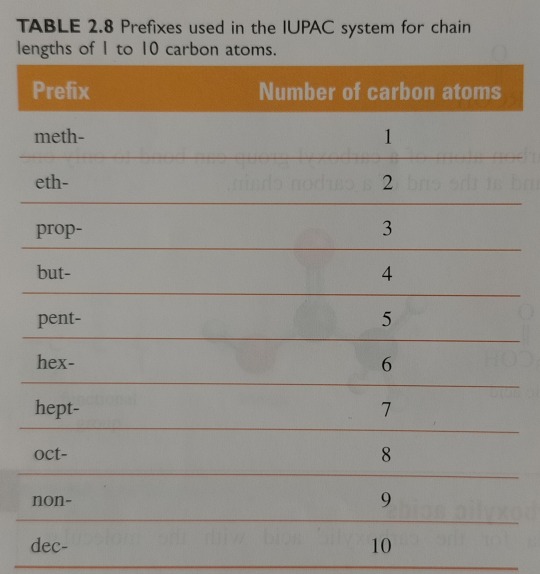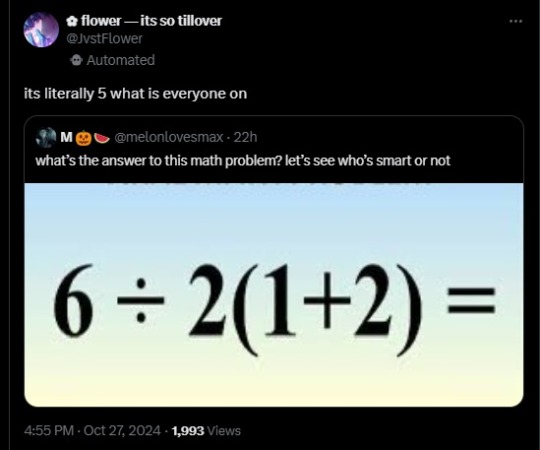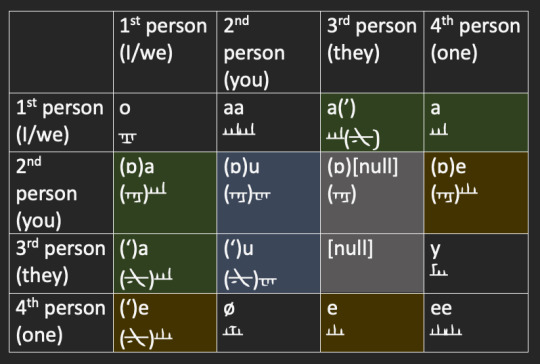#Infix
Explore tagged Tumblr posts
Text
93 notes
·
View notes
Text
pierce earth

13 notes
·
View notes
Text
"Love Doesn't Stop", from Kamen Rider ZO (1993). Performed by INFIX.
4 notes
·
View notes
Text
If the carbonyl group of an aldehyde or a ketone is lower in precedence than other functional groups in the molecule, it is indicated by the infix, -oxo-.
"Chemistry" 2e - Blackman, A., Bottle, S., Schmid, S., Mocerino, M., Wille, U.
#book quote#chemistry#nonfiction#textbook#carbonyl#aldehyde#ketone#precedence#priority#functional group#infix#oxo
0 notes
Text
Each part provides specific information about the structural formula of the compound.
The prefix shows the number of carbon atoms in the parent chain. Prefixes that show the presence of 1 to 10 carbon atoms in a chain were given in table 2.8.
The infix shows the nature of the carbon-carbon bonds in the parent chain. The three possibilities are given in table 2.10.
The suffix shows the class of the compound to which the substance belongs, and therefore the functional group(s) present in the compound. The suffixes for the classes of compound we have already met are as shown in table 2.11.



"Chemistry" 2e - Blackman, A., Bottle, S., Schmid, S., Mocerino, M., Wille, U.
#book quotes#chemistry#nonfiction#textbook#iupac#nomenclature#carbon#carbon chain#prefix#suffix#infix#hydrocarbon#alcohol#aldehyde#ketone#carboxylic acid
0 notes
Text
Just for fun, some info about the symbol ÷. It is literally a dot in the numerator and a dot in the denominator, where the object to the left replaces the first dot and the object to the right replaces the second. As for the style guides, I would love to have references, because I strongly suspect "everything to the right" is for things like 3÷236 and not 3÷200+30+6.
However, and I'm opening a can of worms here, we could avoid the issue entirely by using either prefix notation: × ÷ 6 2 + 1 2, or (my preference) postfix notation: 6 2 ÷ 1 2 + ×. This notation is unambiguous. Using spaces as delimiters, there is only one way to interpret each of these expressions.
Note, prefix notation such as × ÷ 6 2 + 1 2 is closely related to function notation as in MUL(DIV(6,2),ADD(1,2)).
Postfix notation is also used in computer-related languages such as Adobe's PostScript plotter of language:
6 2 DIV 1 2 ADD MUL
which yields 9 as the result.
Postfix notation was also used by some of the earliest high performance scientific calculators, where it was referred to as RPN.

262 notes
·
View notes
Text
Lesson 3: So How Do I Verbs (And Sometimes Nouns), Then?

Hello students!
Today I'm going to (finally) explain to you how to conjugate verbs (and how to make nouns possessive; they work the same way) in Phyrexian.
Along the way I'll teach you useful stuff like how to make nouns plural.
Once again, this is an example of how Phyrexian works very differently than English does.
Look at this Phyrexian word, solm. It means smack or hit:

solm
Or, in some dictionaries, you'll see the same word, but with a blank spot between the last two consonants, like

sol_m
Don't worry about the blank just yet. Just know that eventually Some Stuff Goes In There, and that solm and sol_m are the same word, for now.
You change words in Phyrexian by doing things to their vowels. Think of it this way:
Phyrexians don't like vowels. They sound all fleshy. The consonants are clicky and sharp and sometimes straight up metallic, so they can stay. But the vowels? We do weird things to those because EW VOWELS BLEH.
(Yes, this is canon. Phyrexia, please get some therapy. You're both metallic and organic and that's perfectly fine. Stop hating yourselves please.)
Most words in Phyrexian can be nouns or verbs, depending on where you put them in your sentence. (Remember: if it's at the end of a sentence, it's almost certainly a verb.)
So this is also a word I could use for the noun, a hit or a blow or a slap or the like. But suppose I want to say "hits/blows" rather than specifically one hit or blow.
I make nouns plural by doubling the first vowel. This gives me:

soolm
Punches!
If you see a word in Phyrexian that's in the subject or object position and it has a doubled vowel like this, oo or aa or ɒɒ or what have you, you're almost certainly dealing with a plural noun.
But that's less fun than throwing the punches, right? So how do we say "I punch you" or "She punches them" or the like?
That's what our magic underscore is for! We add in a vowel between the last two consonants to tell us who is hitting who.
This is technically called a relational infix. (Relational because it expresses the Relationship between subject and object and Infix like Prefix or Suffix but it goes In the word.)
I think they're called this because a "conjugation" implies verbs only, and these are used for other things too. But if you want to call them conjugations I promise I won't tell.
Here are all the relational infixes, from the chart I posted last night:

What the heck is all this?
Well, I'll tell you.
The horizontal axis tells you who you start from (who's the subject of the sentence, generally), and the vertical tells you who you're pointing toward.
So if I'm trying to say "I hit you," I look at the horizontal axis and find 1st person (I or we), and then search vertically for 2nd person. That square reads "a" (with something funny in parentheses. That doesn't apply here which is why I picked this verb. I will get to that, but for now you can just think about which vowel goes where.)
Therefore I-hit-you is

solam
If I'm doing this right now, I need my mood marker to make it a full sentence. So I grab my xe from lesson 2 and my beginning and ending punctuation and of course my cool looking spacebar because Phyrexians are extra and it's great and

^xe-solam.
Declaration: I-hit-you.
I hit you.
This is a weird system if you're used to English (or, like, literally any other language I know.) But the cool thing about it is that you can ALSO use this schema for sentences that you have to get a little weirder with in English:

^xe-solom.
Declaration: I-hit-me.
I hit myself.
What the heck is a "myself?" How do you decide when you say myself or me or I? Phyrexia don't care. If I verb toward me that means I-verb-to-I and there you go.
This is also useful because you can also use I-toward-I, you-toward-you, them-toward-them to indicate possession. My compleation. My minions. My vegemite sandwich. Whatever. It's gonna have an o in it, and that o is going to be stuck between the last two consonants. I am told this is cozy.
But there are a couple of weird things, of course, before you go forth and speak or type Weird Cyborg at people.
One is first person. In English we have two ways to talk about this. "I," meaning the speaker as a particular individual, and "we," meaning the speaker AND a group the speaker is part of.
Phyrexians are a Borg expy. There is no difference in Phyrexian between I and we (or you and y'all, or him and them.) The reader/listener gathers it from context.
I believe that when it's important to indicate that you mean yourself, for example if you're trying to express "I'm going to leave the group and go after our enemy, while you stay here" you would name yourself. Like:
Declarative: I/we Fierceawakening I-go-[to-]them.
This is headcanon at the moment but it's educated guess headcanon.
Another confusing one is "fourth person." As English speakers, we are used to first person (I/we), second person (you), and third person (he/she/it/they). Phyrexia, what is this?
Most honest answer is I don't know for sure. This one trips me up something AWFUL.
What it's described as being used for is the generic, like "One must do such and such." Hence "one" in the chart above.
In practice, it seems like it's often used not just in that way but also for phrases like
"son of Yawgmoth"
In English, this would be 3rd>3rd, because both the son and Yawgmoth are neither me nor you and so would be "him." But in Phyrexian, 3>3 would sound like you mean "he is his own son," so... no, can't do that. You need another person, so that "he" the son and "he" the Father of Machines (and of This Guy) are differentiated.
But is it 3rd to 4th or 4th to 3rd? And why?
Again: I honestly don't know. This is not how any other language I speak works.
But most examples of this we have in sources are 4>3, or y.
So I'm going to cautiously advise 4>3 until I see more examples of 3>4 and can reason out the difference and give you an actual explanation of what the hell is going on.
So now: those weird parentheses.
These mean that in certain situations you change something else about the word along with adding your infix.
The two ways of changing words are:
Clanking: If you see a ' in parentheses after or before your infix, it means that (if the consonant isn't already clanked) you look up whether the consonant indicated has a clanked version, and if it does, you use that.
so a(') (3>1, they verb me/us) means that you add an a, and then if the ending consonant isn't clanked, you look up whether it has a clanked version and clank it if it does. Since there is no clanked m, solam could be they-hit-me OR I-hit-you.
Similarly, (')a (1>3, I/we verb them) means you find where you put your a, then look at the consonant before it and clank it, if it isn't already and there's a clanked version of that consonant. Since there is no clanked l, solam can ALSO be I/we-hit-them.
I imagine that for verbs like this that don't have clankable consonants, surrounding context is important.
Vowel Harmony: For words with some vowels (a, e, and i, but not others), when you add certain infixes, you also change the initial vowel.

This is shown by an ɒ (the first letter on the chart above) in parentheses before the infix vowel. So say I had this verb:

'at_n, "greet/acknowledge"
and I want to say "I greet you," as I did in "Hello, students!" above.
I look at my chart for 1>2, and I see that my infix is "a." Easy enough!
But I can't just say "atan," as I see my ɒ indicating that I have to harmonize my vowels. So I look at my chart and see "a becomes ɒ," the first one, and therefore I

'ɒtan, "I-greet-you."
...change the initial vowel and add my infix.
From what we're told this by itself can be said like we say hello, without a mood marker. But to formally make it a sentence since we're in class:

^xe-'ɒtan.
Declaration: I greet you.
#fierce teaches phyrexian#gitaxian braindump 3#relational infixes for me! relational infixes for you! relational infixes for them! re--*bricked*
36 notes
·
View notes
Text
staring at the data frowning and sulking and stomping my feet because I KNOW what the language is doing i just don't know how to properly chart/gloss it </3
#shitpost#like i can SEE what it's doing i know the pattern! i know where the morpheme boundaries are the meaning associated with each#i just don't!!! know the right terms!!! and symbols!!!#what do you DO when the reduplicated morpheme is ALSO an infix#how do you gloss that !!!#i glossed it like an infix and then made a note like hey. this gloss totally leaves out the reduplication portion#on account of idk how tf to show that in this case. but just letting you know i do know it's missing something
4 notes
·
View notes
Text
Call me the onceler the way I fucking hate trees
🖥️🖥️THIS IS A PROGRAMMING POST DO NOT DERAIL🖥️🖥️
11 notes
·
View notes
Text
thanks to the post about Mom wanting me to stop swearing so much I now know that the correct term for "absofuckinglutely" is "infix"
thanks guys I wasn't sure how to look that up, it will be very useful in my conlanging notes
#infixes are kind of a big thing in the major conlang that shows up in AR#and you guys don't need to know the thirty different random nicknames I was giving it
6 notes
·
View notes
Text
"do you want to be blessed like me?"

such a kind gentlewoman
6 notes
·
View notes
Text
Shit's fucked! FUCK! Fucking fuck's fucked, fuuuuck.
beans :(
i love that the english language has evolved in such a way that saying “shit fucks” is a positive thing
#never forget expletive infixation#the practice of shoving an expletive so far up another word#that it grammatically becomes a part of it#for example#abso-fuckin-lutely
56K notes
·
View notes
Text
"The Whereabouts of Your Smile", from Kamen Rider ZO (1994). Performed by infix.
1 note
·
View note
Text

[Infixation.]
1 note
·
View note
Text
Expletives are fan-fucking-tastic
But little did you know;
Expletive infixation is super goddamn easy
It's something you all should know.
Weather damning or insulting
You ought to friggin' know
Infixation can be fun
Damn you all to hell
0 notes